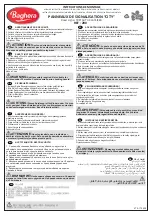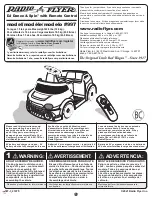
3
DE - Sender und Empfänger binden
Bei einer modernen 2,4 GHz Anlage ist es unbedingt notwendig, dass der
Sender und der Empfänger im Modell aneinander gebunden werden. Der
Empfänger akzeptiert dann nur noch die Signale seines Senders.
Sollten Sie aus irgendwelchen Gründen die Bindung neu durchführen wollen,
gehen Sie bitte wie folgt vor:
A. Setzen Sie aufgeladene Akkus oder neue Batterien in den Sen-der ein.
Lassen Sie den Sender ausgeschaltet.
B. Stecken Sie den beigefügten Bindungsstecker in den 3. Kanalausgang.
C. Schalten Sie die Empfangsanlage ein, indem Sie den Empfängerakku
mit dem Empfänger verbinden.
Je nach Softwareversion signalisiert
Ihr Empfänger unterschiedlich den Bindemodus (statt blinken
leuchtet z.B. die LED oder bleibt ganz aus).
Der Bindevorgang als
solches ist aber bei allen Versionen gleich. Die LED am Empfänger
fängt an zu blinken und zeigt damit an, dass der Empfänger sich im
Bindemodus befindet.
D. Halten Sie die Bindetaste am Sender gedrückt und schalten Sie gleich-
zeitig den Sender ein.
E. Der Sender beginnt zu blinken und zeigt an das er im Bindemodus ist.
F. Lassen Sie die Bindetaste am Sender los und trennen Sie den Empfän-
ger vom Empfängerakku, bzw. schalten den Regler aus. Entfernen Sie
nun den Bindungsstecker am Empfänger.
G. Schalten Sie nun den Sender aus. Die Anlage ist beim nächsten Ein-
schalten gebunden..
H. Installieren Sie alles ordnungsgemäß und überprüfen Sie alles sehr
genau
I. Sollte die Funktion nicht erfolgreich verlaufen, wiederholen Sie die Bin-
deprozedur.
Die Abbildung stellt grafisch den Bindevorgang dar und kennzeichnet die ein
-
zelnen Elemente die bedient werden müssen.
GB - Binding the receiber to the transmitter
As with all modern 2.4GHz R/C systems the receiver must be bound to the
transmitter to ensure that the receiver will only react to signals from that trans-
mitter.
If you wish to re-bind the receiver with the transmitter please proceed as fol-
lows:
A. Ensure that the transmitter is fitted with fresh or fully charged batteries
and leave the transmitter off.
B. Plug the binding plug (included) into the channel 3 socket on the re-
ceiver.
C. Switch the receiver system on by connecting the battery or turn in a
BEC operating on a controller to control.
Depending on your soft
-
ware version of your receiver indicates the different binding mode
(instead of flashing lights for example LED or remains out comple
-
tely).
The binding process as such is in all versions. The receiver LED
will begin to flash indicating that the receiver is in bonding mode.
D. Press and hold down the binding button on the transmitter whilst switch-
ing it on.
E. The transmitter will begin to flash indicating that the receiver is in bon
-
ding mode.
F. Release the binding button on the transmitter and disconnect the re-
ceiver from the battery or turn off the controller. Release the binding
plug from the receiver.
G. Switch of the transmitter. And remove the binding wire. The system be
bound at the next start .
H. Install all properly and check anything very precisely.
I. If the receiver fails to bond or does not function after bonding repeat the
above procedure until a successful bonding is achieved.
The diagrams illustrate the bonding process and show the locations of the
relevant components.
Bindungsstecker
Binding Plug
Fail Safe
Setup LED
Programmierung der integrierten FailSafe-Einheit
1. Funktionsbeschreibung
Die integrierte FailSafe-Einheit ist hauptsächlich für den Einsatz bei Booten und Fahrzeugen gedacht. Sie dient
dazu den Verlust des Models hervorgerufen durch einen hängenden Gaskanal bei Signalverlust zu verhindern.
Wenn der Empfänger das Signal zum Sender verliert, kehrt der Servo oder Speedregler des Gaskanals automa-
tisch in die zuvor eingestellte Position zurück.
2. Einstellung
a. Schalten Sie den Sender ein
b. schalten Sie den Empfänger ein. Die Signal-LED leuchtet dauernd und zeigt an, dass der Empfänger
betriebsbereit ist.
c. Bringen Sie den Gashebel am Sender in die Neutralposition Ihres Servos oder Speedreglers.
d. Drücken Sie die Setup Taste am Empfänger. Die Signal LED blinkt für 3 Sekunden (siehe Abb. links).
e. Lassen Sie sie wieder los. Die Einstellung ist gespeichert.
3. Testen der Einstellungen
a. Schalten Sie den Sender ein.
b. Schalten Sie den Empfänger ein.
c. Schalten Sie den Sender aus.
d. Der Empfänger verliert nun das Signal und fährt den Servo bzw. den Speedregler am Gaskanal auf die zuvor
einprogrammierte Position zurück.
e. Folgt der Ablauf den obigen Schritten funktioniert die
FailSafe-Funktion korrekt.
How to setup the fail safe function
1. The instruction of function
The function of protection of losing control is mainly for r/c boats and cars and keeps them away from damage
through throttle channel. When the receiver is out of control signal, the receiver of throttle will automatically return
to the initial position which set up before starting to avoid the error action :
2. How to set the function
a. Switch on the transmitter power and enter into the working condition
b. Connect the receiver with power and enter into the working condition, the signal light on receiver will blink all the
time.
c. Control the throttle of transmitter and keeps the servo or ESC in the neutral position.
d. Press the setting button, the LED will be flash for 3 seconds (see on pict. left).
e. Release the setting button. The setting is finished.
3. Testing
a. Switch on the transmitter and enter the working condition.
b. Contact the receiver with power and enter the working condition.
c. Turn off the power of transmitter.
d. The throttle of servo will be set automatically.
e. Finish these steps above means the setting is ok.
Technische Daten:
Max. Belastung
60 A
Kurzzeit Belastung
380 A
Innenwiderstand
0,0007 Ohm
Einsatzbereich
RC-Cars 1:10
Akkus
4 - 9 NiCd- / NiMH-Zellen
2 - 3 LiPo-Zellen
BEC-Spannung
6,0 V
BEC-Belastung
1,5 A
Motor-Typen
sensorlose BL-Motoren
Schutzeinrichtung
Übertemperaturschutz/Unterspan-
nungsabschaltung/Eingangsimpul-
skontrolle
Größe
~ 31,5 x 27,5 x 24 mm (mit Lüfter)
Gewicht
~ 32 g (ohne Anschlusskabel)
Programmierbar
11 Programmierschritte (Bremse,
Unterspannung, Startmodus etc.)
Technical data:
Max. Current
60 A
Burst Current
380 A
Internal Resistance
0,0007 Ohm
For Use With
Cars or Trucks scale 1:10
Battery packs
4 - 9 NiCd- / NiMH cells
2 - 3 LiPo cells
BEC Voltage
6,0 V
BEC Current
1,5 A
Motor Types
Sensorless Brushless motors
Protective Circuits
Temperature cut-off/Low voltage
cut-off/input signal
Size
31,5 x 27,5 x 24 mm (with fan)
Weight
32 g (without cable)
Programmable
11 Programming steps (Break,
Low Voltage, Start Mode etc.)
Einbau und Anschluss
Schließen Sie den Regler, den Empfänger, den Akku, das Lenkservo und den
Motor nach dem folgenden Diagramm an. Achten Sie unbedingt auf die rich-
tige Polung des Antriebsakkus. Verbinden Sie das rote Kabel mit dem ’+’Pol
und das schwarze mit dem ’-’Pol des Akkus. Die Anschlüsse ’#A’, ’#B’ und
’#C’ müssen mit den Motoranschlüssen verbunden werden. Die ’SET’-Taste
dient zur Programmierung. Verbinden Sie den Empfängerausgang „Kanal 2“
über das Anschlusskabel mit dem Regler. Beachten Sie die Belegung der
Kanäle Ihrer Fernsteuerung. Verbinden Sie die Ausgänge des Reglers mit
den Motoranschlüssen. Eine vorgegebene Zuordnung gibt es dabei nicht.
Nachdem alles angeschlossen ist, führen Sie einen Probelauf durch. Sollte
der Motor die falsche Drehrichtung haben, stecken Sie zwei beliebige Mo-
toranschlusskabel um.
Hinweis:
Sie können über die Reverse-Funktion am Sender, die Drehrichtung des
Motors ändern. Beachten Sie aber unbedingt, dass der Regler danach neu
kalibriert werden muss.
Using Your ESC
Connecting the Receiver, Battery Pack and Motor
Connect the ESC, the receiver, the battery pack, the steering servo and the
motor together following the diagram below.
Ensure that you observe the correct polarity of the battery pack. The red cable
should be connected to the ‘+‘ Plus Pole and the black cable to the ‘-‘ Minus
Pole. The ’#A’, ’#B’ and ’#C’ plugs are connected to the motor. The ‘SET‘
button initiate the programming mode.
The ESC should be plugged into the throttle channel of your receiver which
is normally channel 2. If in doubt, check your Radio- Control System’s inst-
ructions. The 3 Motor wires can now be connected, these connectors can be
plugged in any order, and if the motor rotates in the wrong direction any 2 of
the wires should be swapped.
Note:
You can use the servo reverse function of your transmitter to reverse the mo-
tor direction but the ESC will have to be re-calibrated afterwards.
DE - Regler (eingebaut) | GB - Controller (installed)
Motor
#A, #B, #C
Regler/ESC
Kanal/channel 2
Schalter
Switch
Empfänger
Receiver
Lenkungsservo
Steering servo
Plus pole
rotes Kabel
red cable
Minus pole
schwarzes Kabel
black cable


































